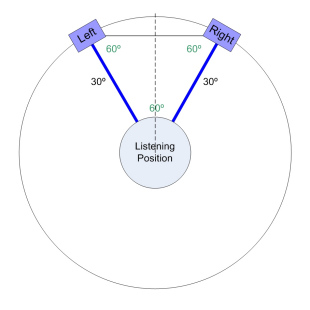
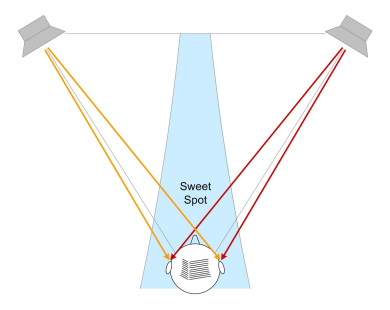
Two Stereo Loudspeakers are positioned each 30 degrees out of axis left and right to create an angle of 60 degrees between each other. The stereo speakers and the preferred listening position (the hot spot) create an equilateral triangle between Speaker L - Speaker R - Listener. The angle of 60 degrees is agreed between many professionals as the optimal listening angle. If spaced farther apart phantom images between the two speakers are not stable anymore.
Each loudspeaker's signal is heard with both ears, at each ear with a slight delay. This is important to get directional hearing, in stereo listening to locate both speaker's position.
Additional to the delay received at both ears from one speaker, the general delay of the signal from the 'left' and the 'right' speaker is received and processed at the auditory system and brain. At the exact center point of the 'sweet spot' this delay is zero and both speaker's signals are received at the same time (right side image).
 |  |
|
| optimum stereo arrangement | both ears hear both speakers (one ear delayed to the other) |
| A | a stereo recording with stereophonic microphone setup to capture the locations of different sound sources along the 'recording baseline'. The resulting stereophonic recording should be a (somehow) identical image of the real audible situation. This is used to record classical concert etc. |
| B | a stereo mix that is built from individual channels (e.g. of a mixing board), the resulting stereophonic image is completely artificial. This is used for any multitrack mix of temporary music, pop music etc. |
The hearing of phantom images along the baseline between the stereophonic loudspeakers is a psychoacoustic phenomenon. Signals from both sides (left and right speaker) are compared in our auditory system and brain. Hearing to identical signals from both sides creates the imagination of sound coming straight from the center of the baseline.
The basic intensity stereophonic system was invented by Alan Blumlein in 1931. Two identical signals played from the left and right speaker and heard at the center line (60 degree setup described above), create a phantom image at the middle of the stereo baseline. A level increase at one side (left or right) will move the phantom image to the left or right side. This is only valid for the 'sweet spot', there both speakers can be heard with about the same time difference (delay between the arriving sounds).
If 100% different signals are fed to the left and right speaker, no phantom image will be created, both speaker's signals are heard independently. All usual music or other stereo mixes contain a part of monophonic signals and a part of 'pure' stereo signals with no monophonic parts within both stereo signals. The monophonic signals with a certain amount at both speakers will move as soon as the listener moves to the side. The 'pure' stereo signal the right channel that has no counter part in the left channel (and vice versa) is still heard just from this speaker. With these both extreme versions of signals in the stereo mix ('pure' left and 'pure' right signals and signals with certain amounts in both channels) at each position from the center line ('sweet spot') to on side the heard spatial mix is changing too.
This is caused by the precedence effect (see Precedence Effect) or law of the first wave front.
The 'channel mixed' stereophonic recording (version B, above) is also called 'pan pot stereo' (from the "pan"-orama "pot"-entiometer of a mixing board). The individual monophonic signals in the stereo image are fed to both left and right channel. The signals are fed to both channels without a delay, with no time difference between the left and right channel.
For a listener at the center of the 'sweet spot' both parts of the signal (left channel portion and right channel portion) are arriving at the same time at the listener's ears. The phantom image will be heard at the center of the stereo baseline. As soon as the signal levels in the left and right channel change and create a level difference the phantom image moves to the side of the higher level.
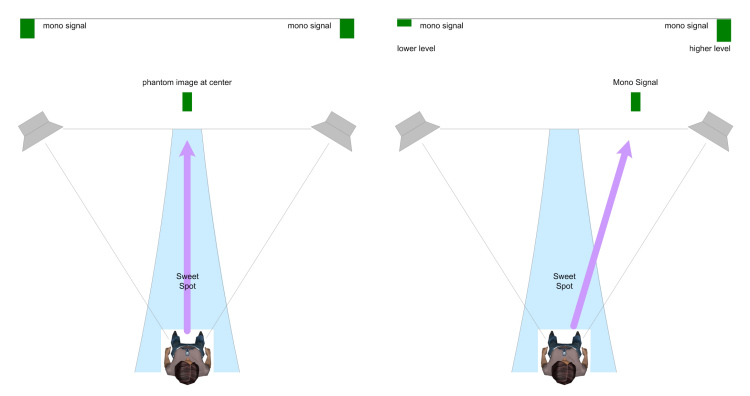 |
| monophonic signals with equal level and non-equal level at the left and right channel |
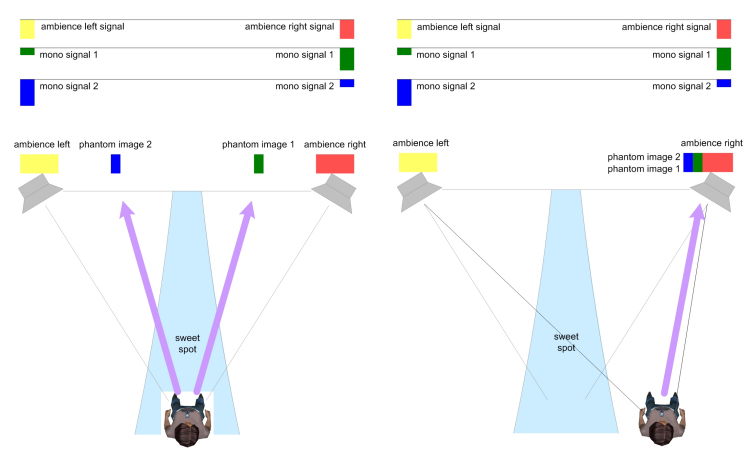 |
| left: level differences at the left and right channel create a moving phantom image, right: with the listener out of the 'sweet spot', the phantom image moves completely to the nearer speaker, but the images of 'pure' stereo signals (yellow and red) are unchanged |
It is used for the 'channel mixed' stereophonic recording (version B, above). Using the precedence effect, phantom images can be moved by delaying the monophonic amount in the left or right channel. If a monophonic signal is fed to both channels with the same intensity at the same time, it would create a phantom image at the center. As soon as one of both portions is delayed for a certain mount of time, the phantom image moves to the side with the shorter delay (first arriving signal, first wave front).
Using this method many different phantom images can be created over the stereo baseline, each with a different delay ratio between left and right. The big advantage of time difference stereo is that the individual monophonic signals have the same level at both channels. Listening to just one channel the exact relationship between the monophonic signals is preserved at the left and the right channel. The big disadvantage is that a good mono mix of both channels is not possible! The monophonic signals are contained at both channels with different delays. Mixing both channels to mono would result in each signal twice, creating comb filtering. Because of this the time difference stereo is not possible at any broadcast situation where mono compatibility is necessary. It can be used very well for live sound reinforcement.
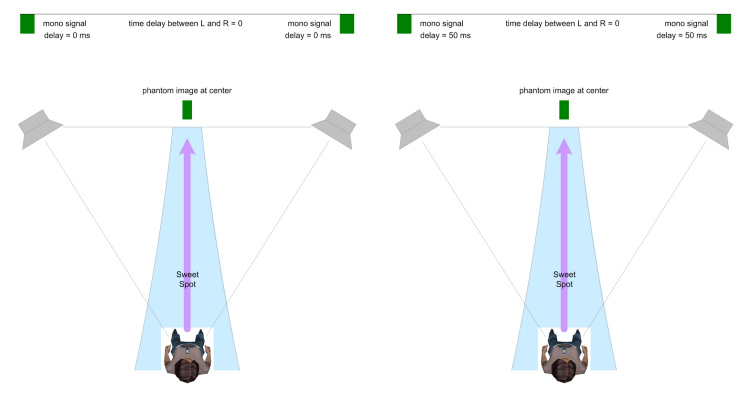 |
| monophonic signals with equal delay and equal level create a center phantom image |
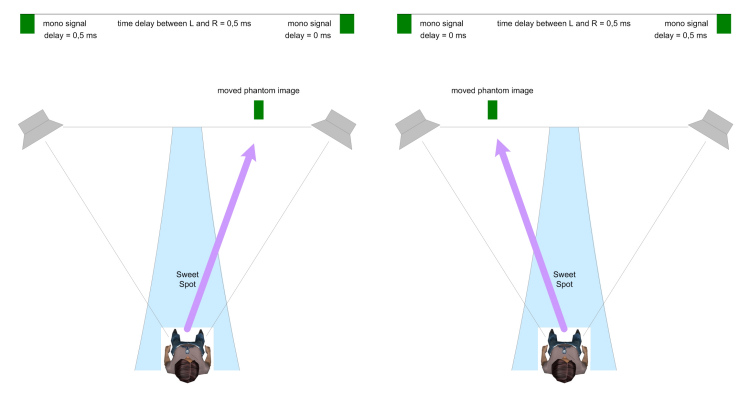 |
| arrival time difference (signal delay) moves the phantom image to the side of the first arrival |
The center channel in a sound reinforcement system can be 'created' in two ways: a real loudspeaker at center position (three-channel stereophonic sound) or a phantom image between the two stereo channels. For both methods a different mix should be used. Using a two-channel mix for a three-channel setup causes some specific problems.
The phantom image always seems to be located further away from the stereo baseline than a 'real' speaker. This probably is caused by room reflections that distort the perceived image and create a changed psychoacoustic image location.
Music is mixed with this effect in mind to sound well in a typical two-channel stereo setup. If this mix is played through a three-channel stereo setup, the center image (now a real image and no phantom image) seem to be too present, too much outstanding.
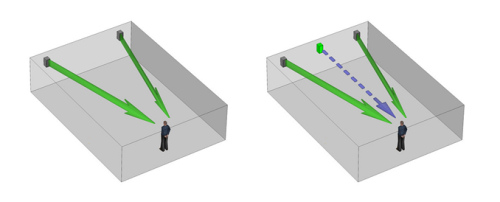 |
| phantom center image or 'real' center channel |
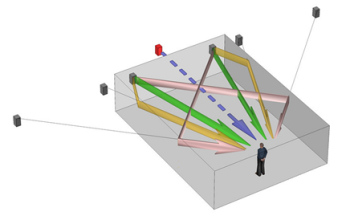 |
| reflections of the left and right speaker distort the phantom image, reflections create a 'further away' center image |